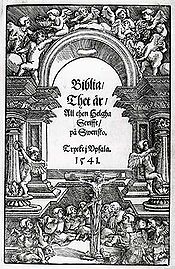
Gustav Vasa Bible
Encyclopedia

Swedish language
Swedish is a North Germanic language, spoken by approximately 10 million people, predominantly in Sweden and parts of Finland, especially along its coast and on the Åland islands. It is largely mutually intelligible with Norwegian and Danish...
Bible translation published in 1540-41. The full title is as appears on the right: Biblia / Thet är / All then Helgha Scrifft / på Swensko. Translated into English it reads: "The Bible / That is / All the Holy Scripture / In Swedish".
The men behind the translation were Laurentius Andreae
Laurentius Andreae
Laurentius Andreae was a Swedish clergyman and scholar who is acknowledged as one of his country's preeminent intellectual figures during the first half of the 16th century...
and the Petri brothers Olaus
Olaus Petri
Olof Persson , better known under the Latin form of his name, Olaus Petri , was a clergyman, writer, and a major contributor to the Protestant Reformation in Sweden...
and Laurentius
Laurentius Petri
Laurentius Petri Nericius was a Swedish clergyman and the first Evangelical Lutheran Archbishop of Sweden. He and his brother Olaus Petri are, together with the King Gustav Vasa, regarded as the main Protestant reformers of Sweden...
. Of them, Archbishop Laurentius is regarded as the main person. However, had the work not been commissioned by the Swedish King Gustav Vasa, who had in effect broken with the Pope
Pope
The Pope is the Bishop of Rome, a position that makes him the leader of the worldwide Catholic Church . In the Catholic Church, the Pope is regarded as the successor of Saint Peter, the Apostle...
in Rome in the 1520s, the work would not have been possible.
The Bible follows the German version by Martin Luther
Martin Luther
Martin Luther was a German priest, professor of theology and iconic figure of the Protestant Reformation. He strongly disputed the claim that freedom from God's punishment for sin could be purchased with money. He confronted indulgence salesman Johann Tetzel with his Ninety-Five Theses in 1517...
from 1526 closely, not only in language, but in the fonts used and the typography as a whole. The Danish version, printed a few years earlier, also did this.
The Bible established the use of the Swedish language
Swedish language
Swedish is a North Germanic language, spoken by approximately 10 million people, predominantly in Sweden and parts of Finland, especially along its coast and on the Åland islands. It is largely mutually intelligible with Norwegian and Danish...
. It established a uniform spelling of words, particularly the infinitive ending -a instead of the more Danish-sounding -e, and defined the use of the vowels å, ä and ö. It did use th for /ð/, as in English, as is apparent on the title page; but this eventually changed to d.
This Bible text was, with revisions, basically the only Swedish Bible used before 1917. It was reprinted as a facsimile in 1938 and 1960. Few people today, however, are able to read the text with ease. This has to do partly with the spelling and partly with the typeface.

